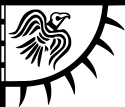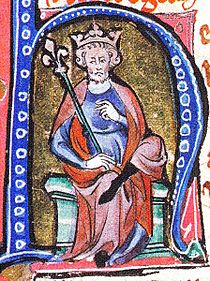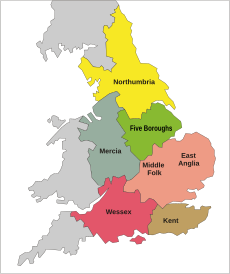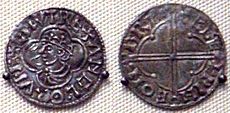North Sea Empire facts for kids
The North Sea Empire, also known as the Anglo-Scandinavian Empire, was a special kind of union of kingdoms. It brought together England, Denmark, and Norway for much of the time between 1013 and 1042. This happened near the end of the exciting Viking Age. This empire was ruled by Norsemen, who were people from Scandinavia. It was a "sea empire" (a thalassocracy), meaning its different parts were connected and depended on the sea.
The first king to rule all three kingdoms was Sweyn Forkbeard. He had been king of Denmark since 986 and Norway since 1000. He conquered England in 1013. But he died the next year, and his lands were split up. His son, Cnut the Great, took over England in 1016, Denmark in 1018, and Norway in 1028. Cnut died in 1035, and his empire was divided again. However, his successor in Denmark, Harthacnut, also became king of England in 1040 and ruled until he died in 1042. When Cnut ruled all three kingdoms (1028–1035), he was one of the most powerful leaders in western Europe.
Quick facts for kids
North Sea Empire
|
|||||||||||||||||||
|---|---|---|---|---|---|---|---|---|---|---|---|---|---|---|---|---|---|---|---|
| 1013–1042 | |||||||||||||||||||
|
The raven banner was used by Cnut the Great and many other Scandinavian rulers.
|
|||||||||||||||||||
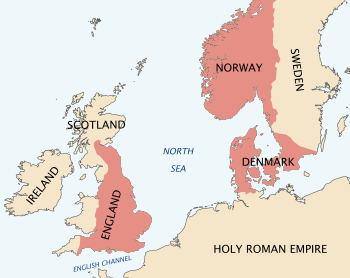
The dominions of Cnut the Great. (The Swedish and Norwegian lands of Jämtland, Härjedalen, Idre and Särna are not included in this map.)
|
|||||||||||||||||||
| Status | Personal union of Denmark, Norway and England | ||||||||||||||||||
| Capital | Ribe, Denmark | ||||||||||||||||||
| Common languages | Old Norse, Old English | ||||||||||||||||||
| Religion | Christianity, Norse paganism | ||||||||||||||||||
| Government | Personal union monarchy | ||||||||||||||||||
| King | |||||||||||||||||||
|
• 1013–1014
|
Sweyn Forkbeard | ||||||||||||||||||
|
• 1016–1035
|
Cnut the Great | ||||||||||||||||||
|
• 1040–1042
|
Harthacnut | ||||||||||||||||||
| Historical era | Viking Age | ||||||||||||||||||
|
• Sweyn Forkbeard conquers England
|
1013 | ||||||||||||||||||
| 1016 | |||||||||||||||||||
|
• Cnut the Great became King of Denmark
|
1018 | ||||||||||||||||||
| 1026 | |||||||||||||||||||
|
• Death of Harthacnut
|
1042 | ||||||||||||||||||
|
|||||||||||||||||||
Contents
What's in a Name?
Historians started using the name "North Sea Empire" in the early 1900s. However, people thought of Cnut's lands as an empire much earlier. For example, in 1623, a writer named John Speed used the idea in his book. Back then, people just called the union by its separate parts: the kingdoms of Denmark, Norway, and England.
How the Empire Was Formed
The North Sea Empire grew as powerful kings took control of more lands. Let's look at how each kingdom joined this union.
England's Role
Cnut was the younger son of the Danish king Sweyn Forkbeard. When his father died in England in 1014, Cnut was in charge of the fleet. The Danes wanted him as king. But the invasion failed, and the English nobles brought back their old king, Æthelred.
Cnut's brother, Harald, became King of Denmark. But Cnut gathered a new fleet and returned to England in 1015. England was divided by arguments among its leaders. Soon, Cnut controlled Wessex, an important part of the kingdom. King Æthelred died in 1016. The people of London chose his son, Edmund, as king. But most nobles supported Cnut.
Cnut surrounded London. He fought Edmund at the Battle of Otford. Later, Edmund was defeated at the Battle of Assandun. They made a deal: Edmund would rule Wessex, and Cnut would rule the rest of England. But Edmund died in November 1016, making Cnut the King of England. In 1017, Cnut married Æthelred's widow, Emma, to make his power stronger. By 1018, he was fully recognized as king.
Denmark's Role
King Harald of Denmark died without children in 1018 or 1019. This left Denmark without a king. Cnut was his brother's heir, so he went to Denmark in 1019 to claim the throne. He told his English subjects he was abroad to stop a "danger." He returned to England only to stop small rebellions.
Kings Olaf II of Norway and Anund Jacob of Sweden saw Cnut's combined Anglo-Danish kingdom as a threat. They attacked Denmark in 1025 or 1026. Cnut surprised Olaf's fleet and fought the Swedish fleet at the Battle of the Helgeå. Cnut won, and the threat to Denmark ended.
In 1027, Cnut traveled to Rome. He wanted to show his importance as a ruler. He made sure that travelers from Northern Europe paid fewer tolls on their way to Rome. He also started a good relationship with the Holy Roman Emperor, Conrad II. This led to Conrad's son marrying Cnut's daughter. The Emperor also gave Denmark some land back.
Norway's Role
Olaf II had become powerful in Norway. Cnut had a long-standing dislike for Olaf. In 1024, Cnut offered to let Olaf rule Norway as his subject. But after the Battle of Helgeå, Cnut worked to weaken Olaf's rule by offering bribes. In 1028, Cnut sailed to Norway with 50 ships to take control.
Many Danish ships joined him. Olaf retreated, and Cnut sailed along the coast. He landed at different places and received promises of loyalty from local chiefs. Finally, in Nidaros (now Trondheim), he was declared king. Within a few months, Olaf fled to Sweden. In 1030, Olaf tried to return, but the people of Trondheim did not want him. He was defeated and killed at the Battle of Stiklestad.
Parts of Sweden
After the Battle of Helgeå, Cnut also said he ruled "part of Sweden." This was along with England, Denmark, and Norway. He might have had coins made in Sweden with "Cnut King of the Swedes" on them. This likely meant he had some control or influence over parts of Sweden, like Western Geatland or Blekinge. However, Cnut did not have to be in Sweden to order coins to be made. Some coins even said he ruled Ireland.
Some sources say that the Swedish king Anund Jakob won the Battle of Helgeå. If the Danes controlled Sweden, it was only for a short time. By 1030, Anund was clearly in charge of Sweden again.
Other Areas That Paid Tribute
Besides parts of Sweden, Cnut received payments from the Wends (a Slavic people). He was also allied with the Poles. In 1022, he sailed into the Baltic Sea to confirm his rule over coastal areas that Danish kings had controlled.
After his trip to Rome, Cnut led an army into Scotland. He made Malcolm, the high king of Scotland, and two other kings his subjects. One of these kings ruled lands that included Galloway and the Isle of Man. He later became king of Dublin. All these rulers, and likely the Welsh, paid tribute to Cnut. This was similar to the Danegeld that English kings had paid to the Danes. Cnut was bringing back control over these Celtic kingdoms. An Icelandic poet called Cnut "king of the Danes, the Irish, the English and the Islanders."
Religion in the Empire
By the early 1000s, England had been Christian for many centuries. The Danelaw (areas in England settled by Danes) was slowly changing from paganism to Christianity. But the Scandinavian countries were still mostly pagan. Cnut's father, Sweyn, had been pagan at first but became Christian later.
In England, Cnut strongly supported the Church. This helped him gain acceptance from other Christian rulers in Europe. No other Scandinavian king had been given such respect before. In Norway, Cnut built churches and was kind to the clergy. But he also made friends with pagan chiefs. Unlike Olaf, he did not make laws to help the Church until his power was very strong.
How the Empire Was Ruled
In 1017, Cnut divided England into four large areas called earldoms. This was like the Scandinavian system. He ruled Wessex directly. His allies, Thorkell the Tall, became Earl of East Anglia, and Eric Haakonsson kept Northumbria. Eadric Streona became Earl of Mercia, but he was soon removed and executed. In 1018, Cnut brought back some earldoms in Wessex. At a meeting in Oxford, English leaders agreed that Cnut would rule under the laws of King Edgar.
Historians say that the Anglo-Saxon Chronicle doesn't say much about Cnut's rule in England. This suggests he was in strong control. Thorkell probably acted as his regent (someone who rules for the king) when Cnut was away. Later, Cnut and Thorkell had a disagreement, and Thorkell was exiled. They later made up, and Thorkell became Cnut's regent in Denmark.
However, another of Cnut's earls, Siward, helped protect Northumbria. By the time Siward died in 1055, he, not the king, controlled all the land that the Kingdom of Strathclyde had taken earlier.
The Danes had more reason to complain about Cnut's absences than the English. He mostly ruled from England, leaving regents in charge of Denmark. He replaced Thorkell as his main advisor in England with Godwin, an Englishman. Godwin became Earl of Wessex. Within three years, Thorkell was also replaced as regent of Denmark by Ulf Jarl, Cnut's sister's husband. Ulf also became the guardian of Cnut's son, Harthacnut.
Ulf was not very loyal. He plotted against Cnut with the kings of Sweden and Norway. Then he tried to gain more power by having nobles promise loyalty to Harthacnut, which would effectively make Ulf more powerful. Cnut returned to Denmark in 1026. He ordered his guards to kill Ulf, which they did in a church. By the end of his life, Cnut had replaced his Scandinavian advisors with Englishmen.
In Norway, Cnut stayed for a while and then left Jarl Erik's son, Hakon, in charge as his regent. But Hakon drowned the next winter. Cnut sent his younger son, Swein, and Swein's mother, Ælfgifu, to rule Norway. They were not popular. Ælfgifu tried to bring in new taxes and stricter rules. The Norwegians valued their independence and disliked these Danish customs.
Cnut also planned to give Denmark to one of his sons. When he took power in Norway, he declared Harthacnut, his son with Emma, king of Denmark. This shows that Cnut did not plan for his empire to stay united after he died. It might have been the custom of his people to divide lands among sons. It was clear that the empire's weakness was finding loyal and good regents to rule when Cnut was not there. And his sons could not keep it together.
The Empire Falls Apart
The North Sea Empire quickly fell apart after Cnut died in 1035. In Norway, it was already collapsing. By the winter of 1033, Swein and Ælfgifu were so disliked that they had to leave Trondheim. In 1034, leaders brought King Olaf's young son, Magnus, back from Gardariki to rule. In autumn 1035, just before Cnut's death, Swein and his mother had to flee Norway entirely and go to Denmark. Swein died soon after.
In Denmark, Harthacnut was already king. But he could not leave for three years because Magnus of Norway threatened to invade. Meanwhile, the English nobles were divided between Harthacnut and Cnut's younger son, Harold Harefoot. They decided Harold would rule as regent. By late 1037, Harold was firmly in power as Harold I. Harthacnut's own mother, Queen Emma, had to seek safety in Flanders.
Harthacnut prepared a fleet to take England from his half-brother. But Harold died in 1040 before the fleet was used. Harthacnut then became king of England, bringing it back together with Denmark. But he was not a popular king. The Anglo-Saxon Chronicle said he "never did anything royal" during his rule. He died suddenly in June 1042 at a wedding feast.
At first, Harthacnut's death seemed to end the North Sea Empire. However, Magnus of Norway had an agreement with Harthacnut from 1040. He took control of Denmark and planned to invade England to reunite the kingdoms. While making his power strong in Denmark, he defeated an invasion by the Wends. This might have weakened the very forces that helped Cnut rise to power.
Later, Sweyn Estridsson took Denmark from Magnus in 1047. The Anglo-Saxon Chronicle says that Sweyn asked England for ships to fight Magnus. "And then Sweyn expelled Magnus from Denmark... And the same year Magnus died." This marked the true end of the North Sea Empire.
See Also
- Kalmar Union
- List of English monarchs
- List of Danish monarchs
- List of Norwegian monarchs
- List of possessions of Norway
- Norse activity in the British Isles
- Viking expansion


